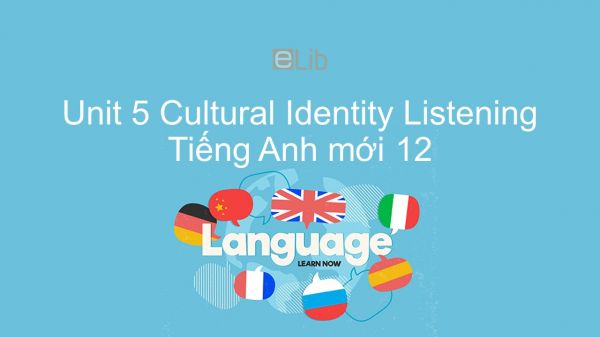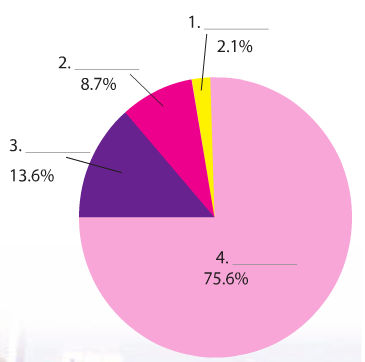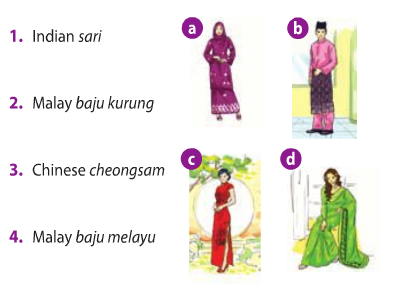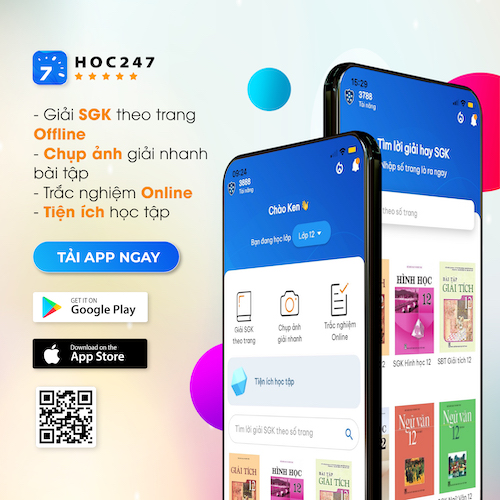Unit 5 lớp 12: Cultural Identity - Listening
Bài học Unit 2 Lớp 12 mới phần Listening hướng dẫn các em nghe và thực hành một số bài tập liên quan đến sự đa dạng văn hóa ở các nước, đặc biệt là ở Singapore. Mời các em cùng tham khảo!
Mục lục nội dung

Cultural diversity in Singapore (Sự đa dạng văn hoá ở Singapore)
1. Task 1 Unit 5 lớp 12 Listening
You are going to listen to a talk about cultural diversity in Singapore. What do you know about this city-state? Look at the information below. Guess and write the name of each ethnic group in the blank. (Bạn sẽ nghe một cuộc nói chuyện về sự đa dạng văn hóa tại Singapore. Bạn biết gì về thành phố này? Xem các thông tin dưới đây. Đoán và viết tên của từng dân tộc vào chỗ trống.)
SINGAPORE
- Official languages: English , Malay, Mandarin, Tamil (Ngôn ngữ chính thống: Tiếng Anh, Tiếng Malay, Tiếng Quan Thoại, Tiếng Ta-min)
- Ethnic groups : Chinese, Malays, Indians, Eurasians, and other (Các nhóm dân tộc: Người Hoa, Người Malay, Người Ấn Độ, Người lai Á Âu, và các nhóm người khác)
- Currency used : Singapore dollar SGD (Tiền tệ được sử dụng: Đô Sing)

Guide to answer
|
1. Eurasians and other |
2. Indians |
|
3. Malays |
4. Chinese |
2. Task 2 Unit 5 lớp 12 Listening
Work in pairs. Discuss and match the national costumes with their names. (Làm việc theo cặp. Thảo luận và khớp trang phục dân tộc với tên của họ.)

Guide to answer
1. d Indian sari (sari của Ấn Độ)
2. a Malay baju kurung (baju kurung của Mã Lai)
3. c Chinese cheongsam (sườn xám của Trung Quốc)
4. b Malay baju melayu (baju melayu của Mã Lai)
3. Task 3 Unit 5 lớp 12 Listening
Listen to a talk. What is the speaker about? Tick the correct boxes. (Nghe một cuộc nói chuyện. Người nói nói về là gì? Đánh dấu vào các ô đúng.)
Click to listen
Guide to answer
|
1. Singapore’s ethnic groups and official languages (Các nhóm dân tộc và các ngôn ngữ chính thức ở Singapore) |
x |
|
2. Singapore’s traditions and official languages (Truyền thống và các ngôn ngữ chính thức của Singapore) |
|
|
3. Chinese wedding costumes in Singapore (Trang phục đám cưới c ủa người Trung Quốc ở Singapore) |
|
|
4. Malay traditional costumes for men and women (Trang phục truyền thống của người Malay cho nam giới và phụ nữ) |
x |
|
5. Modern Indian costumes for men (Trang phục hiện đại của người Ấn độ dành cho nam giới.) |
|
|
6. The Indian traditional dress (Váy truyền thống của người Ấn độ.) |
x |
Audio script
Singapore gained its independence on 9 August 1965 and now has a population of more than five million people including Chinese, Malays, Indians and Eurasians. The country has four official languages: English, Chinese, Malay and Tamil. Singapore does not have a national costume, as people from the different ethnic groups tend to wear their traditional clothing.
The Chinese traditional attire for ladies is called cheongsam, which means a long garment. Originally, both men and women used to wear this long, one-piece dress specially designed to conceal the body shape. Today it's often worn by Chinese women in Singapore during Chinese New Year celebrations and at traditional wedding ceremonies.
For Malay men, the traditional garment is called baju melayu.
It consists of a loose shirt and a sarong worn over a pair of trousers. Malay women often wear baju kurung, which looks like a long- sleeved and collarless blouse worn over a long skirt.
The traditional dress for Indian women is thesari, which can be not only worn on special occasions, but used every day. It's a long piece of brightly-coloured cloth wrapped around the waist and hung over the shoulder. It's usually decorated with beautiful patterns.
Because of the hot temperatures and the modern character of Singapore, clothing is usually very casual and most people prefer western fashions. For business, men usually wear dark trousers, white shirts and a tie. Standard office attire for women includes a long-sleeved blouse with trousers or a skirt.
Unified by the common goal for a better future, the people of Singapore, especially the younger generations, think of themselves as Singaporeans first, and then as Chinese, Malay or Indian.
Tạm dịch
Singapore đã giành được độc lập vào ngày 9 tháng 8 năm 1965 và hiện nay có hơn 5 triệu dân bao gồm Trung Quốc, Mã Lai, Ấn Độ và Âu Á. Đất nước có bốn ngôn ngữ chính thức: tiếng Anh, Trung Quốc, Mã Lai và Tamil. Singapore không có trang phục dân tộc, vì người dân từ các nhóm dân tộc khác nhau thường mặc quần áo truyền thống.
Trang phục truyền thống của Trung Quốc dành cho phụ nữ được gọi là sườn xám, có nghĩa là quần áo dài. Ban đầu, cả nam giới và phụ nữ đều mặc chiếc váy dài, một mảnh này được thiết kế đặc biệt để che giấu thân hình. Ngày nay nó thường được mặc bởi phụ nữ Trung Quốc ở Singapore trong lễ hội Tết Nguyên đán và lễ cưới truyền thống.
Đối với người Mã Lai, quần áo truyền thống được gọi là baju melayu.
Nó bao gồm một chiếc áo sơ mi lỏng lẻo và sarong mòn trên một đôi quần. Phụ nữ Malay thường mặc baju kurung, trông giống như một chiếc áo dài tay và cổ áo mặc trên một chiếc váy dài.
Các trang phục truyền thống cho phụ nữ Ấn Độ là thesari, mà có thể không chỉ đeo trong những dịp đặc biệt, nhưng được sử dụng hàng ngày. Đó là một mảnh vải màu sáng dài quấn quanh thắt lưng và treo trên vai. Nó thường được trang trí với hoa văn đẹp.
Do nhiệt độ nóng và tính cách hiện đại của Singapore, quần áo thường rất giản dị và hầu hết mọi người thích thời trang phương Tây. Đối với kinh doanh, đàn ông thường mặc quần đen, áo sơ mi trắng và cà vạt. Trang phục văn phòng tiêu chuẩn dành cho phụ nữ bao gồm áo dài tay với quần tây hoặc váy.
Được thống nhất bởi mục tiêu chung cho một tương lai tốt đẹp hơn, người dân Singapore, đặc biệt là các thế hệ trẻ, nghĩ mình trước nhất là người Singapore, sau đó là người Trung Quốc, Mã Lai hoặc Ấn Độ.
4. Task 4 Unit 5 lớp 12 Listening
Listen again and complete the following sentences. Fill each blank with no more than four words or numbers. (Nghe một lần nữa và hoàn thành các câu sau. Điền vào mỗi chỗ trống với không quá bốn chữ hoặc số.)
Click to listen
Guide to answer
1. Singapore gained its independence on 9 August 1965. (Singapore đã giành được độc lập vào ngày 9 tháng 8 năm 1965.)
2. Singapore does not have a national costume, as people from the different ethnic groups tend to wear their traditional clothing. (Singapore khong có trang phục dân tộc, vì người dân từ các nhóm dân tộc khác nhau có xu hướng mặc quần áo truyền thống.)
3. Chinese men and women used to wear cheongsam. (Đàn ông và phụ nữ Trung Quốc thường mặc sườn xám.)
4. Sari is often wrapped around the waist and hung over the shoulder. (Sari thường quấn quanh eo và qua vai.)
5. At office men usually wear dark trousers, white shirts and ties while women wear long-sleeved blouses with trousers or skirts. (Ở nơi công sở, nam giới thường mặc quần dài màu đen, áo sơ mi trắng và dây buộc trong khi phụ nữ mặc áo choàng dài tay.)
6. The young people often think of themselves as Singaporeans first, and then as Chinese, Malay or Indian. (Những người trẻ tuổi thường nghĩ về bản thân họ như người Singapore, và sau đó là Trung Quốc, Mã Lai hoặc Ấn Độ.)
5. Task 5 Unit 5 lớp 12 Listening
Work in pairs. Ask and answer the following question. (Làm việc theo cặp. Hỏi và trả lời câu hỏi sau đây.)
What else do you know about the city-country and its culture? (Bạn còn biết gì về các thành phố của quốc gia và nền văn hóa của nó?)
Guide to answer
There are a lot of other interesting things about Singapore. For example, Singapore is the English word for 'Singapura,' which means Lion City. The lion head symbol was introduced in 1986 as an alternative national symbol of Singapore. The lion head was chosen as a logo, as it best captures the characteristics of Singapore's reputation.
Tạm dịch
Có rất nhiều thông tin thú vị khác về Singapore. Chẳng hạn như Singapore là từ tiếng Anh cho 'Singapura', từ này có nghĩa là Thành phố Sư tử. Biểu tượng đầu sư tử được giới thiệu vào năm 1986 là một biểu tượng quốc gia phụ của Singapore. Chiếc đầu sư tử được chọn là biểu tượng vì nó tóm gọn được những đặc trưng về danh tiếng của Singapore.
6. Practice Task 1
Mark the letter A, B, C or D to indicate the word that differs from the other three in the position of the primary stress in each of the following questions.
Question 1: A. opportunity B. intellectual C. psychology D. civilization
Question 2: A. dormitory B. elementary C. beneficial D. continental
7. Practice Task 2
Mark the letter A, B, C or D to indicate the word(s) CLOSEST in meaning to the underlined word(s) in each of the following questions.
Question 1: The Indigenous experience, like with any form of belonging, is highly fluid and context-specific, meaning there are countless examples of what such cultural pluralities can look like.
A. countable B. uncountable C. too few to count D. too many be counted
Question 2: Steve Kootenay-Jobin, Aboriginal housing coordinator at Mount Royal University, notes that many Indigenous students who move to the city for education, encounter culture shock.
A. avoid B. confront C. overcome D. wipe out
Để biết thêm nhiều từ vựng hỗ trợ quá trình nghe hiểu, mời các em đến với phần luyện tập trắc nghiệm Unit 5 Listening Tiếng Anh 12 mới ngay sau đây.
9. Conclusion
Kết thúc bài học Unit 5 Tiếng Anh Lớp 12 mới – Listening, các em học sinh cần luyện tập nghe, ghi nhớ sự đa dạng văn hóa ở Singapore; đồng thời nhớ các từ vựng sau:
- currency /ˈkʌrənsi/ tiền tệ
- costume /ˈkɒstjuːm/ trang phục
- consist /kənˈsɪst/ bao gồm
- unify /ˈjuːnɪfaɪ/ thống nhất
- characteristic /ˌkærəktəˈrɪstɪk/ đặc trưng
- reputation /ˌrepjuˈteɪʃn/ danh tiếng
Tham khảo thêm
- doc Unit 5 lớp 12: Cultural Identity - Getting Started
- doc Unit 5 lớp 12: Cultural Identity - Language
- doc Unit 5 lớp 12: Cultural Identity - Reading
- doc Unit 5 lớp 12: Cultural Identity - Speaking
- doc Unit 5 lớp 12: Cultural Identity - Writing
- doc Unit 5 lớp 12: Cultural Identity - Communication and Culture
- doc Unit 5 lớp 12: Cultural Identity - Looking Back
- doc Unit 5 lớp 12: Cultural Identity - Project
